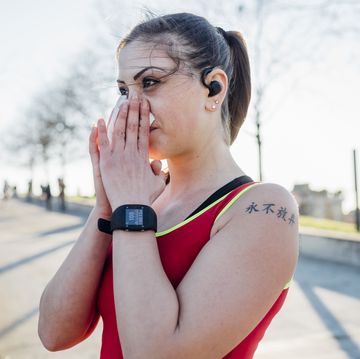After five years of legal battles, South African Olympian Caster Semenya celebrated a victory on July 11. The European Court of Human Rights ruled she’d been discriminated against when World Athletics, track and field’s governing body, told her she must lower her naturally high testosterone levels before competing against other women.
One reason among many she’s fought the directive: the side effects she experienced during hormone suppression. Previously, she told HBO Real Sports her treatments caused her to gain weight and have panic attacks, among other consequences. “It’s like stabbing yourself with a knife every day,” she said.
Despite the judgment in her favor, World Athletics said after the ruling it won’t immediately change its recently updated regulations regarding athletes with differences of sexual development (DSDs). Because high levels of circulating testosterone typically confer advantages in athletic performance, they note, such guidelines are necessary to protect fair competition among females.
Semenya isn’t the only world-class runner affected by the rules. Burundi’s Francine Niyonsaba, the 2016 silver medalist at 800 meters, and Namibia’s Christine Mboma, the silver medalist in the 200 meters at the 2020 Tokyo Olympics, also must reduce their testosterone levels to 2.5 nanomoles per liter for at least six months to compete in any event sanctioned by World Athletics (a change from previous rules mandating levels of 5 nanomoles per liter, and only for certain distances).
Unlike Semenya, who has refused to continue medications, Mboma’s coach has said she’ll comply—although it won’t be in time for the World Championships in Budapest, Hungary, this August. As Semenya’s legal battle continues and other athletes adjust to the guidelines, Runner’s World asked three endocrinologists—physicians who specialize in hormones—to explain the scientific and medical aspects of DSDs and hormone treatments.
What exactly are DSDs?
Differences of sexual development (DSDs) are a group of conditions that affect the reproductive system or genitals. They can occur for a wide variety of reasons, often related to sex chromosomes—the XX or XY usually associated with male or female characteristics—or abnormalities in the way the body produces or responds to hormones like testosterone, says Bradley Anawalt, M.D., an endocrinologist and professor of medicine at the University of Washington School of Medicine who has consulted for the U.S. Anti-Doping Agency and sits on the NCAA Committee on Competitive Safeguards and Medical Aspects of Sports.
The DSDs covered by the World Athletics policy are those that occur when a person is assigned female at birth or has a female gender identity, but also has high circulating testosterone levels and is androgen-sensitive. This means that not only do they have higher testosterone levels than the average woman, their tissues respond to the hormone in ways typically associated with males—making their muscles larger and stronger, for example.
Semenya, Niyonsaba, Mboma, and other athletes covered by the regulations have experienced this. As Semenya has said, she was born and raised female and legally identified that way. However, her condition means she has both naturally high testosterone levels and tissues that, at least in some ways, respond to testosterone’s “instructions.”
Do DSDs require medical treatment if someone isn’t an athlete?
People with signs of a DSD at birth or during puberty—which could include ambiguous genitalia, unexpected changes at puberty, or being female and not getting a period or developing breasts or other secondary sex characteristics by age 14—should have a full medical evaluation, says Richard Auchus, M.D., Ph.D., professor of internal medicine and pharmacology at the University of Michigan and chief of endocrinology at the Ann Arbor Veterans Affairs Health System, who has consulted with World Athletics on similar matters.
For one thing, these symptoms can have other causes that require treatment, including chromosome disorders or eating disorders. In addition, some DSDs are associated with health problems like abnormalities in the kidneys, Auchus says.
While an accurate diagnosis is important, not all DSDs require treatment. However, some women with high testosterone might choose to suppress their levels to reduce unwanted body hair, acne, or other effects of the hormone, says Kathryn Ackerman, M.D., M.P.H., a sports endocrinologist and director of the Wu-Tsai Human Performance Alliance and Boston Children’s Hospital Female Athlete Program.
Some people with a DSD seek gender-affirming care: hormones or other treatments that better align their bodies with their perception of themselves, Auchus says. Decisions about these therapies are personal and should be made through private, honest conversations between patients and doctors. “This is not easy medicine to practice. I think being open about all the options and what to expect is best,” he says.
What, exactly, does suppressing testosterone entail?
The updated World Athletics guidelines don’t stipulate how to lower testosterone levels, just that they must be reduced to 2.5 nanomoles per liter for at least 24 months to compete in the female category at any event. This is a change from the previous policy, in which only athletes competing in events between 400 meters and the mile were required to lower their testosterone levels, and to 5 nanomoles per liter instead of 2.5.
Athletes like Mboma, who previously competed in events that didn’t require changing testosterone levels, fall under a special “transitional” provision in the new regulations. They are only required to have lowered their testosterone for six months before competing in the same events again.
Hormone suppression for gender-affirming care follows a “stepwise progression,” Auchus says, and a similar approach can be used in sports. This would begin with hormone treatments typically used to prevent pregnancy, like hormonal birth control pills or patches.
Some people with DSDs will be able to bring their testosterone levels down by taking estrogen alone. Others may need to add progesterone or its synthetic version progestin, another female sex hormone that suppresses the natural production of testosterone.
If those don’t bring testosterone down enough or aren’t well tolerated, doctors can prescribe a medication called a gonadotropin-releasing hormone (GnRH) agonist, such as Lupron (generic name leuprolide), Anawalt says. These drugs prevent the pituitary gland from releasing hormones that, in turn, prompt the body to produce testosterone. They’re also used to treat conditions like prostate cancer and early-onset puberty, and are given as injections once every month to three months.
Many people with DSDs have internal testes. Regardless of whether they’re athletes or not, they can be offered—but not forced to have—surgery to remove them, Auchus says. (The World Athletics policy specifically notes that surgery is not required, under any circumstances.) Doing so will also lower testosterone levels and can reduce the risk the internal testes become cancerous later on, which is common, Ackerman says.
Are there risks and side effects to testosterone-suppressing treatments?
Whether they’re used to qualify for athletic competition or for other reasons, hormone therapies—like any other medical treatments—do have some downsides.
“If you were doing an article on how well or how poorly hormonal birth control methods are tolerated, you would find a number of women who would say, this didn’t work for me,” Anawalt says. Side effects of estrogen and progestin can include headaches, nausea, mood changes, weight gain, and bloating. The most serious risks include blood clots, which can be reduced by using a patch instead of pills and avoiding synthetic estrogens, Auchus says.
Lupron and other GnRH inhibitors can cause similar symptoms to menopause, including hot flashes and loss of sex drive. However, taking estrogen at the same time minimizes that effect, Auchus says. Other side effects may include nausea, diarrhea, mood shifts, feeling tired, and muscle, joint, or bone pain.
Those who stay on hormone suppression for an extended period could experience a decrease in bone density, increasing their risk of stress fractures and osteoporosis. However, taking the right dose of estrogen alongside GnRH inhibitors protects bones, Auchus says. More research is needed to understand these dangers—and athletes can be monitored for this risk with bone density tests such as DEXA scans, Ackerman says.
What do doctors and medical associations say about the ethics of these policies?
No one should be forced to have any type of medical treatment against their will, Auchus says. And athletes with DSDs haven’t cheated or done anything wrong. “DSD athletes have grown up in this body. Often, this is who they are, they’ve had great athletic success. And they don’t want to have to change how they were made,” Ackerman says. They may also have religious concerns or a general aversion to any type of medical treatment.
However, Auchus says, there’s a difference between being compelled to take a medication and choosing to do so to compete in a specific category. In his mind, a bigger ethical issue occurs when doctors or athletic federations don’t offer athletes a full medical evaluation or diagnosis, or give them incomplete information about their own bodies when they have signs of a DSD.
Anawalt says this situation, like others in sports, raises questions about priorities. “Our adoration of elite athletic performance has created all sorts of unhealthy incentives to do bad things for your body,” he says—noting, for example, football players gaining extreme amounts of weight. “Now we’re talking about, for people who identify as female, asking them to use therapies that they might not otherwise. That does create some unease.”
Indeed, the World Medical Association and the American Medical Association have both issued statements objecting to the policy, and physicians’ participation in it, since the previous version was introduced in 2019.
In the end, the question of who’s eligible to compete in each category isn’t just a medical or scientific question; it’s also a social one, Ackerman says. Answering it should involve a wide range of stakeholders working together to make informed decisions—choices that are undoubtedly difficult, as Semenya’s ongoing case makes clear.
“This is a clash of two really important values—the individual’s ability to control her body in this case, and not be forced to do something in order to participate in an activity that she values, versus the perception of fairness to others,” Anawalt says. “It is just not going to be readily resolved.”
..
Cindy is a freelance health and fitness writer, author, and podcaster who’s contributed regularly to Runner’s World since 2013. She’s the coauthor of both Breakthrough Women’s Running: Dream Big and Train Smart and Rebound: Train Your Mind to Bounce Back Stronger from Sports Injuries, a book about the psychology of sports injury from Bloomsbury Sport. Cindy specializes in covering injury prevention and recovery, everyday athletes accomplishing extraordinary things, and the active community in her beloved Chicago, where winter forges deep bonds between those brave enough to train through it.













